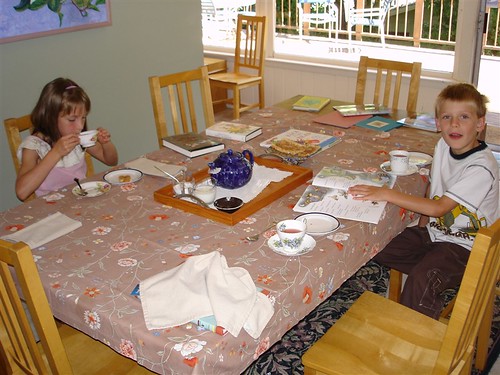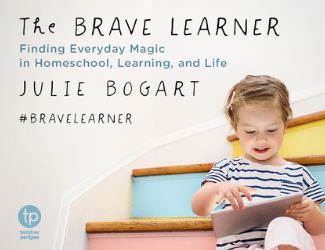Write using the following three words:
- warped
- brush
- aquamarine
Write using the following three words:
Posted in Friday Freewrite, General | Comments Off on Friday Freewrite: Three words
I never get tired of hearing how Brave Writer students fare in college composition classes. Just yesterday, I ran into one of my local friends. I helped her son write his college admissions essay. He also took Kidswrite Basic back in junior high when I taught it. This is not a kid who I remember for his writing. He struck me as a typical boy writer who simply needed some coaxing to discover that the thoughts in his head deserved to be recorded in writing. He is more than able to tell a good story about himself and his experiences given the right set of questions and time to develop his thoughts. In working with him on the admissions essay, it was very enjoyable for me to see him develop insight into his experiences (more than merely reporting them).
So when I ran into his mom, she stopped me to say, “Dan got his first essay back in English Comp 101 at Miami of Ohio.”
“Oh?” I said. “How’d he do?” I expected her to tell me he had done well, earning an A or B (figuring she wouldn’t stop me to tell me he failed).
“Well, he not only got an A on his paper, the professor asked him to sign a permissions notice so that the department could publish his essay in the English department journal as an example of what a well-written essay should look like for incoming freshmen.”
“Nuh-uh,” I replied articulately.
“Yuh-huh,” she countered. And we both cracked up. Dan – her son, not her naturally-gifted writing daughters.
There’s something about those opening hooks, the ease with which Brave Writer kids learn to express themselves combined with their confidence in applying their writing voices to academic formats. Their writing wins over their professors. It keeps happening.
If you have a story to tell, please share it here!
Posted in Alumni, Brave Writer Philosophy, General | 2 Comments »
Hi Julie,
We are just starting with The Writer’s Jungle this fall. The idea of Tea Time caught my fancy and I decided it would be a good excuse to get out the formal tea cups that have been stuck on the shelf, like forever. I knew my 8 yo daughter would be excited about the idea, but I was less sure how to sell it to my 6 yo son. Inspiration hit when I ran out of time to make cookies the day before. We were at the store picking up something else, so I told each child they could pick out one package of cookies for our Tea Time the next day. With pink and white frosted animal cookies in one hand and Nilla wafers in the other, we headed home.
The kids could hardly wait for Tea Time the next day, knowing their cookies were waiting! So, for our first tea time, we had animal cookies and Nilla wafers with formal tea cups and read poetry from a random selection of books I hastily pulled off the shelf. I counted it a success and thought I’d try it again in a couple of weeks.
The next Tuesday came around, and I was quite surprised when my son was the one to ask, “Mom, are we having Tea Time today?” I hadn’t really planned on it, but he insisted he wanted to. (I think his motivation was the animal cookies, which were long gone by this time…) I used your suggestion and made “lady fingers”, and while the tea was brewing both kids found books to read from. My daughter read several poems by Shel Silverstein, and my son read from You Read to Me, I’ll Read to You.
After two weeks, my kids consider Tea Time an integral part of our week, and my good china tea cups are getting more use than they’ve ever seen. I couldn’t be happier!
One more story about Brave Writer Lifestyle and our home… We’ve been doing copywork several times a week. The kids are choosing whatever they want to copy, and there is often a scramble and lots of page turning when I announce it is time to find something to copy. I have been enjoying taking the time to start my own copywork journal alongside them.
Yesterday, as I was reading to them, I came across a particularly descriptive passage that I wanted to call their attention to. I stopped, went back, re-read the passage, and asked for their comments. My son, surrounded on all sides with Legos, looked up and said, “Mom, I know what you can do! If you like that section that much, you can do it for copywork!”
It is amazing how quickly they catch on! Thank you for introducing us to new ways to make Language Arts fun!
Jennifer

Posted in General, Poetry Teatime | Comments Off on Tuesday Teatime: When it comes together
Hi Julie,
I want to start “jotting it down”, but I have a big question. My language-challenged son is awesome at building things out of Legos, K’nex, etc. I love when he shows me his creations, and I take photos for both of our benefits. But when he describes his gadget to me, it involves the word “thing(s)” repeated over and over, pointing to all the various parts and explaining how he put it all together. On paper it is absolutely unintelligible.
He is the student I most need to encourage in writing and I would love to capture him in words, but I feel like I can’t. I thought you might have some ideas for me. Thanks.
Sharon
—
Fabulous question!
“Things” is his shorthand for what’s in his head. He’s finding the work of selecting words more difficult than pointing and building. You can help him by modeling (suggesting) words. So when he says, “And then he’s got this thing that goes like this and it blows up this other thing and the thing in his hand is the thing that he uses to kill that guy’s thing over there….” Slow him down. Point to the first of the “things.” Ask him: Help me better understand what this “thing” is. Is it a weapon? If he says, “Yes,” follow up: What kind of weapon is it? What is it similar to? How does it work?
If he doesn’t know what it is or what to call it or what it’s like, you can offer casually, “Wow, this thing reminds me of a boomerang. It’s got that cool bend in it. Do you think it kills bad guys by clocking them in the head or by throttling them across the throat?”
In other words, you can express the kinds of descriptions you hope to hear from him yourself, asking him if you are close to the right kind of description, close to what his aim was. You need to do this for a long time, over time to help him get there himself. You model the kind of response you hope to hear, and then you ask questions and jot down his answers. You can also jot down your descriptions when he agrees with them, as he gets comfortable with you pressing gently for more information. (Only press to his edge – don’t push him to despair.) So in other words, if he accepts your description, use it. Jot it down as part of the whole. Later when you read it back to him in the context of his own thoughts, he’ll begin to see how better descriptions fit into his natural speech. He’ll learn to emulate your use of descriptions and specific terminology.
As you get comfortable together, you can move from showing him how it’s done through your own comments and example to asking better questions and letting him work to find the answers. The key is to slow him down to focus on one thing at a time (literally one “thing” at a time :)).
Julie
Posted in Email, General | 6 Comments »
When it might hurt their feelings, how do you feel about telling your friends the truth?
Posted in Friday Freewrite, General | Comments Off on Friday Freewrite: The truth hurts

I’m a homeschooling alum -17 years, five kids. Now I run Brave Writer, the online writing and language arts program for families. More >>
IMPORTANT: Please read our Privacy Policy.















